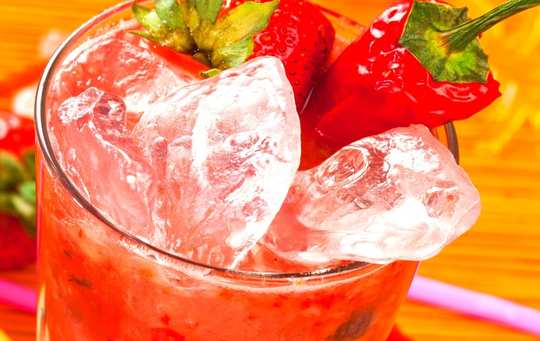People all across the world like carbonated beverages, also referred to as sodas. These beverages are carbonated, which means that carbon dioxide gas has been dissolved in them. While these beverages are delightful to consume, shaking them might be risky.
Why Do Carbonated Drinks Explode When Shaken? Carbonated drinks explode when shaken because the carbon dioxide gas, which is dissolved in the liquid, becomes agitated and forms bubbles. Shaking the drink releases pressure and triggers a rapid release of gas, resulting in a fizzy and sometimes messy eruption when the container is opened.

Why Do Carbonated Drinks Explode When Shaken (Explained)
Carbonated drinks can explode when shaken because shaking causes the carbon dioxide gas in the drink to become more dispersed, leading to an increase in pressure within the container.
This can cause the container to rupture or the drink to fizz over when opened. Carbon dioxide gas is what creates the carbonation in drinks, and when the gas is disturbed, it tries to escape the container quickly, which can lead to an explosive release.
To prevent carbonated drinks from exploding when shaken, it’s important to handle them gently and avoid shaking or agitating the container excessively.
Understanding Carbonation
Carbon dioxide gas is dissolved under pressure in the liquid in carbonated beverages.
It is this gas that causes the froth and bubbles in these beverages. The carbon dioxide gas is kept dissolved in the liquid by the pressure inside the container.
When the container is opened, the pressure is released, allowing the liquid’s carbon dioxide gas to escape and rise to the surface.

Surface Tension’s Function
When carbonated drinks are shaken, surface tension is a key factor in the explosion that results.
The ability of a liquid to resist breaking apart is known as surface tension, and it is caused by the strength of the bonds that hold the molecules of the liquid together.
Shaking a carbonated beverage causes the liquid to move, generating turbulence and lowering surface tension.
The carbon dioxide gas can now escape from the liquid and form bubbles, which rise to the surface as a result of the surface tension being reduced.
Impact of Pressure on Carbonated Drinks
Pressure has a crucial role in how carbonated beverages behave. The carbon dioxide gas is kept dissolved in the liquid by the pressure inside the container.
Shaking a carbonated beverage increases the pressure inside the bottle, which forces the carbon dioxide gas to escape from the beverage.
An explosive release of liquid and gaseous carbon dioxide could ensue from the container bursting as a result of this rise in pressure.
Role of Container Design
Another crucial element in how carbonated drinks behave is the container’s shape.
The amount of pressure generated when the beverage is shaken can vary depending on the size and form of the container.
For instance, because there is less room for the carbon dioxide gas to escape, a bottle with a narrow neck will exert more pressure than one with a wide mouth. Similar to this, a smaller-volume bottle will exert more pressure than a larger-volume container.

Conclusion
In conclusion, a combination of factors including surface tension, pressure, and container design cause carbonated beverages to burst when shaken.
Turbulence is produced by the liquid’s motion, which lowers the surface tension and permits the gaseous carbon dioxide to escape from the liquid.
The container may rupture as a result of the increased pressure, releasing gas and liquid carbon dioxide in an explosive manner.
For these beverages to be consumed safely, it’s crucial to comprehend the science behind carbonated beverages.
Frequently Asked Questions
Why Do Fizzy Drinks Explode When Shaken
Fizzy drinks can explode when shaken due to the release of carbon dioxide gas from agitation, building pressure inside the container.
Why Do Soft Drinks Explode When Shaken
Soft drinks may explode when shaken because shaking releases trapped carbon dioxide gas, creating pressure that can cause the container to burst.
Why Do Sodas Explode When Shaken
Sodas can explode when shaken because shaking disturbs the equilibrium of dissolved carbon dioxide, leading to pressure buildup and potential container rupture.
What Causes Soda to Explode When Shaken
Shaking soda disrupts the dissolved carbon dioxide, forming bubbles and increasing pressure, potentially causing the soda to burst when opened.
Why Does Shaking a Soda Make It Explode
Shaking a soda creates bubbles of carbon dioxide gas, increasing pressure inside the container and causing it to explode upon opening.
Why Soda Explodes When Shaken
Soda explodes when shaken due to the agitation-induced release of carbon dioxide gas, leading to increased pressure inside the container.
Why Does Soda Explode When Shaken
Shaking soda disturbs the equilibrium of dissolved carbon dioxide, resulting in pressure buildup that can cause the soda to explode.
Burst Carbonation
Burst carbonation occurs when the pressure inside a shaken carbonated beverage container becomes too great, causing it to burst or explode.
Explode Drink
A drink can explode if shaken vigorously, as the release of carbon dioxide gas generates pressure that can rupture the container.
Why Does Shaking Soda Make It Explode
Shaking soda creates bubbles of carbon dioxide gas, increasing pressure inside the container, which may lead to an explosion when opened.
Shaken Soda Bottle
A shaken soda bottle can explode when opened due to the release of pressurized carbon dioxide gas.
Shaking a Soda Can
Shaking a soda can agitates the liquid, causing carbon dioxide gas to come out of solution, leading to increased pressure and potential can rupture.
Why Does Soda Explode When You Shake It
Soda can explode when shaken because shaking agitates the liquid, causing the release of carbon dioxide gas and building internal pressure.






